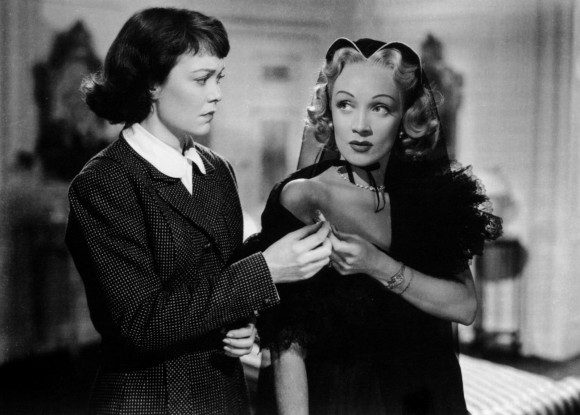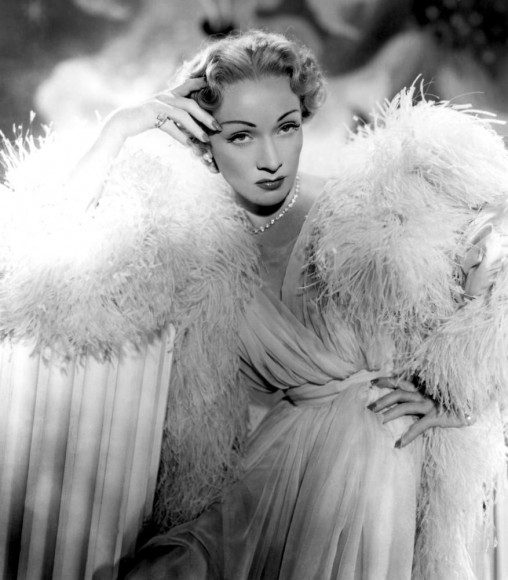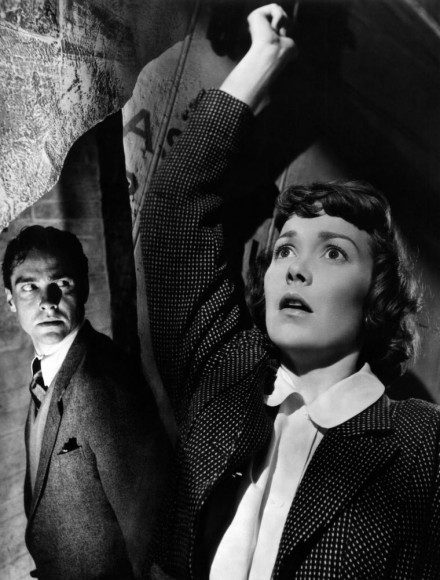Alfred Hitchcock. The name itself just feels synonymous with great filmmaking at this point. One man, so many timeless classics. The voyeuristic paranoia of a wheel chair-bound Jimmy Stewart. Cary Grant’s unforgettable date with a crop duster. The most iconic murder of all cinema. What some little indie magazine says is the greatest film of all time. Practically half of his artistic oeuvre is titanic gospel that has shaped and defined modern cinema.
I’m not here to talk about any of those movies.
We all know that Rear Window, Vertigo, and Psycho are masterpieces. We’ve seen the films a million times, we’ve heard the arguments – we get it. So let’s step outside the canon and take look at one of Hitchcock’s less revered films. Let’s put away the “greatest hits” album and focus on a forgotten B-side. Let’s talk about a buried treasure, about a forgotten gem. Let’s talk about Alfred Hitchcock’s Stage Fright.
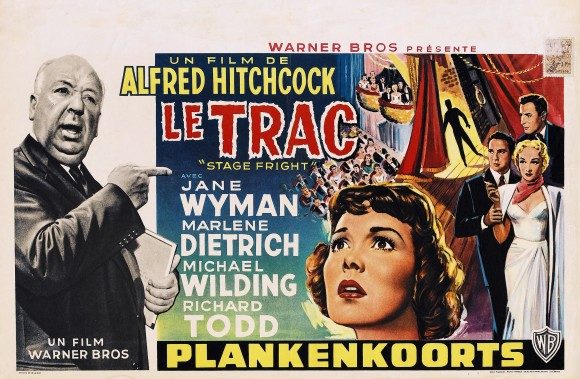

French Poster for the Film.
Stage Fright came out at a curious time in old Alfred’s career: 1950. He’d just finished his first great experimental phase. His last two films, Rope (1948) and Under Capricorn (1949), had both pushed the boundaries of camera movement, restrained editing, and extended takes. His next film after Stage Fright would be Strangers on a Train (1951), a masterpiece of suspense that kicked off the golden age that would give us tour-de-force thriller after tour-de-force thriller. To say that in 1950 the great director was shifting gears would be an understatement, and Stage Fright got lost in the flashy shuffles that were happening on either side of it.
Reception for the film has always been… mixed, to put it kindly. At the time of its release critics called it rambling and ineffectual, and said it was amusing rather scary. Audiences responded very negatively. Discussions of the Hitchcock’s work usually relegate this film to the label of “lesser Hitchcock” or an uneven speed bump. In his book-long interview with Hitchcock, François Truffaut declared that Stage Fright “added little or nothing to [Hitchcock’s] prestige.” Even Hitchcock himself seemed to write it off as a misguided misadventure.
Before we continue, let’s make one thing clear: this film is awesome. It’s not “interesting,” or a “curious misfire.” It doesn’t “have some good things in it,” and it’s most certainly not lesser Hitchcock. Stage Fright is great. It is an astounding display of Hitchcock’s storytelling powers, is assembled with terrifying precision, and is as experimental a film as Rope, albeit in a quieter way. It deserves as much attention as its siblings, and is all around awesome.
Here’s why.
Stage Fright centers on Eve Gill (Jane Wyman, as wide eyed an ingénue as there ever was), a drama student in London. Her life is thrown into chaos when her friend and long-term object of unrequited affection Johnny (Richard Todd) bursts into one of her school rehearsals, the police hot on his trail. It seems that Johnny’s lover, famous stage diva Charlotte Inwood, (played by Marlene “Was I Ever Not Fabulous in Anything? Ever?” Dietrich) has accidentally killed her husband, and a series of unfortunate mishaps have put poor Johnny squarely in the police department’s crosshairs.
While Johnny just wants to elude the law enforcement agents on his trail, Eve suspects there may be more to the death than is immediately apparent. Donning a disguise and assuming a new identity, Eve infiltrates Charlotte Inwood’s household and theater staff hoping to uncover evidence that clears Johnny’s name and shows what really happened. But with the police drawing closer and closer to finding Johnny, it’s a race against time as Eve desperately tries to find who really is the killer before the killer finds out who she really is!
The first striking thing about Stage Fright is how different it feels from other Hitchcock films. The above description sounds Hitchcockean enough, from the wrongfully accused man and the mysterious killer to the race against time. But the film uses these elements more as a motivator than as a driving engine. The focus is less on the hunt for a deadly killer and more on the elaborate games of roleplaying that the characters go through. The tension in the film mostly comes from the trials that Eve must go through to keep up her double life without being discovered. A particularly relentless scene at a garden party finds her having to maneuver between five different groups of people who all think she’s there for a different reason. The furious juggling of lies and identities that ensues is as anxiety-inducing as anything Hitchcock ever did.
So the film is tense, but it’s a different kind of tension than what you’d find in something like The Man Who Knew Too Much or the aforementioned Strangers on a Train. In those films the sinister threat of danger and death looms over everything. This film feels lighter, more mischievous. You know at the end of the day there’s a killer to be revealed, but we’ll get there by way of lies, more lies, some more lies, some cases of mistaken identity, some confusion, more lies, some tricky wordplay, some unintentional lies… the entire things feels like a screwball comedy as written by Agatha Christie.
These might seem like strange bedfellows, but Hitchcock pulls off the delicate balancing act with aplomb. Alfred is not particularly well known for his comedy chops, but on this film the master of suspense’s impeccable senses of timing and pacing translate to humor without missing a beat. There’s an extended transformation scene in this film that is suddenly undercut with a joke, and Hitchcock knows exactly how long the former and how sudden the latter need to be to get a big laugh out of the audience. A big part of the joy of Stage Fright is watching Hitchcock’s talents tackle subjects that are outside his usual wheelhouse. This film even has a full-fledge musical number in it! How often do you get to see a musical number directed by Alfred Hitchcock?
The star of that number is, of course, Marlene Dietrich, who almost steals the show as the villainous Charlotte Inwood. It’s a little hard to believe that this is the only time that she and Hitchcock collaborated, as they work off each beautifully. Dietrich plays Inwood as a diva for whom it’s impossible not be fabulous – she just can’t help herself. When Eve first meets her, she’s getting fitted for a dress to her late husband’s funeral. “This is very nice, if you can call mourning nice,” she tells her dresser, “but isn’t there some way we could let it plunge a little in front?” You almost get the impression that Charlotte would see past Eve’s performance if it weren’t for the fact that she is always giving one herself, desperate for all the people around her to only see her in a single, specific way. It’s a tricky role when you think about it, but Dietrich moves between the different layers of the character so organically that she makes it look like child’s play. She has the charisma to make Charlotte irresistible, but also brings enough nuance to her performance to get us to understand that there is more to this woman than her titanic ego.
In fact, almost every part of this film has a multitude to layers to it, and this is the key to Stage Fright’s greatness. It’s a beautifully unified film, one in which practically every aspect comes back to its central themes of lies, deception, and performance. Every character in the film is playing some sort of part or telling some kind of lie. Eve is an aspiring actress, but the story forces her to play a character off the stage. She thinks Charlotte is a murderer, but the actress has thoroughly convinced the world someone else did it. Even the police are eventually revealed to have a more complicated agenda than they first appear to. The final sequence in Stage Fright takes place in a theater, and as you watch each character desperately try to out-act everyone around them, you realize just how thoroughly every aspect of the film has been tied to its central idea of acting and deceit.
And then there’s the film’s final sequence… Stage Fright has a climax that, for its time, was absolutely revolutionary. Its ending was so radical that a lot of the initial negative reaction the film received was backlash against this one aspect. You can’t really talk about the full extent of this film’s brilliance without describing the ending, but to give it away would be a cinematic crime. So here’s what we are going to do: if you haven’t seen Stage Fright yet, go watch it. Seriously, go. Go right now. Do not peek ahead. I’m going to leave these three large images in the way, and after that I will be diving into a lot of details about this film’s final ten minutes. So seriously, do not proceed unless you’ve seen Stage Fright.
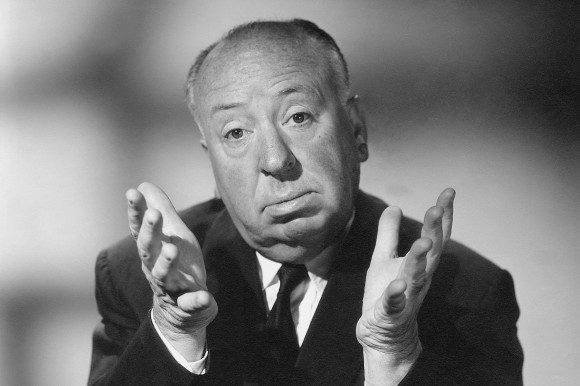

All right, if you really want to know, here’s the secret. Just remember: Alfred and I tried to stop you.
… still with us? Okay, here we go:
After Charlotte’s guilt has been proven, Stage Fright throws one final curve ball at the viewer. A flashback early in the film had shown the viewer how Johnny got wrapped up in the murder investigation. This is now stated to have been a lie, a complete fabrication made up by the character and told to Eve and, by extension, to the viewer. We saw multiple scenes that, in fact, never happened, and we learn that Johnny was the murderer all along.
As Eve finds this out, the style and tone of the film change dramatically. Once Eve finds that she is alone with a psychotic killer, the playful and mischievous tone the film established earlier on completely vanishes. The lighting gets a lot darker, and a lot more dramatic. There’s no laughs or jokes or roleplaying in the last ten minutes of the film: once the lying and the acting is done all you’re left with is the burning question of whether anyone will find Eve and Johnny before he is able to kill her off. It’s an extremely tense, edge-of-your-seat sequence that feels like… well, it feels like something out of an Alfred Hitchcock film.
And this is the final, most brilliant part of Stage Fright’s genius. In a film that is all about lies and roleplaying, the filmmaker was able to find a way to have the film lie to the audience and pretend to be something that it isn’t. It’s not just the characters that have multiple layers and deceitful natures; the movie that contains them gets in on that action. The film doesn’t look or sound like an Alfred Hitchcock film for so long because of a very calculated façade. The film wears a mask for most of its runtime, and once it comes off its true Hitchcockean nature is revealed. Stage Fright is awesome because its form and its content perfectly mirror each other, and, as such, it’s one of the most successful formal experiments that the master of suspense ever conducted.


